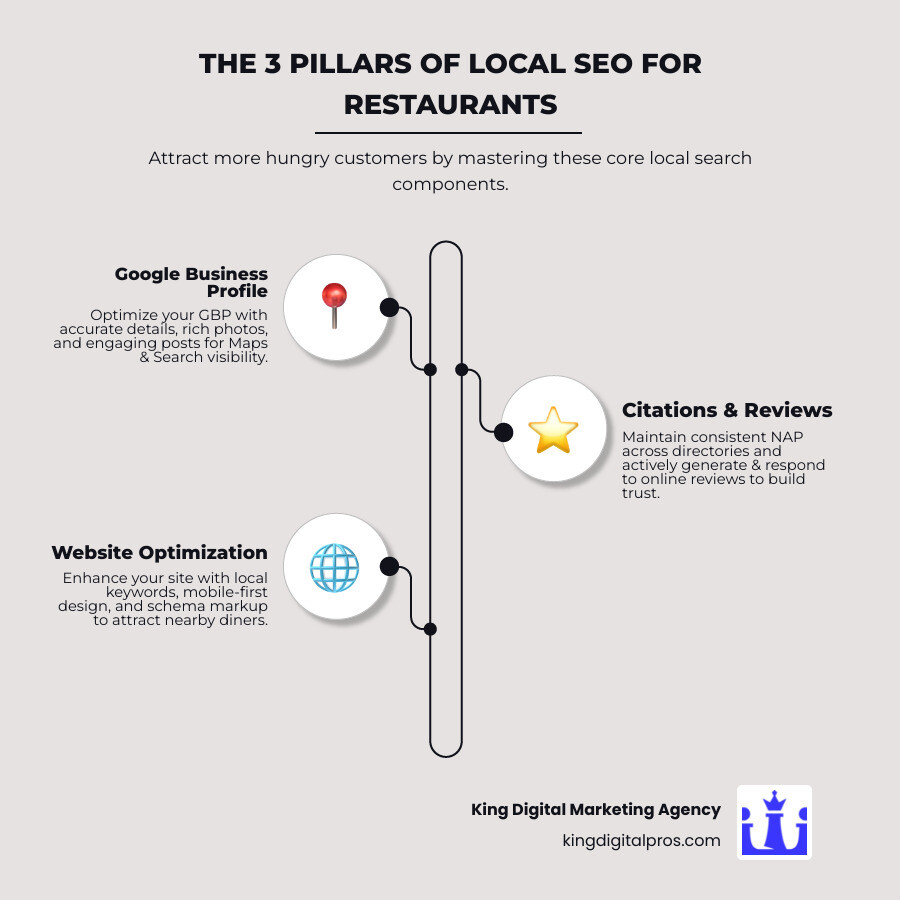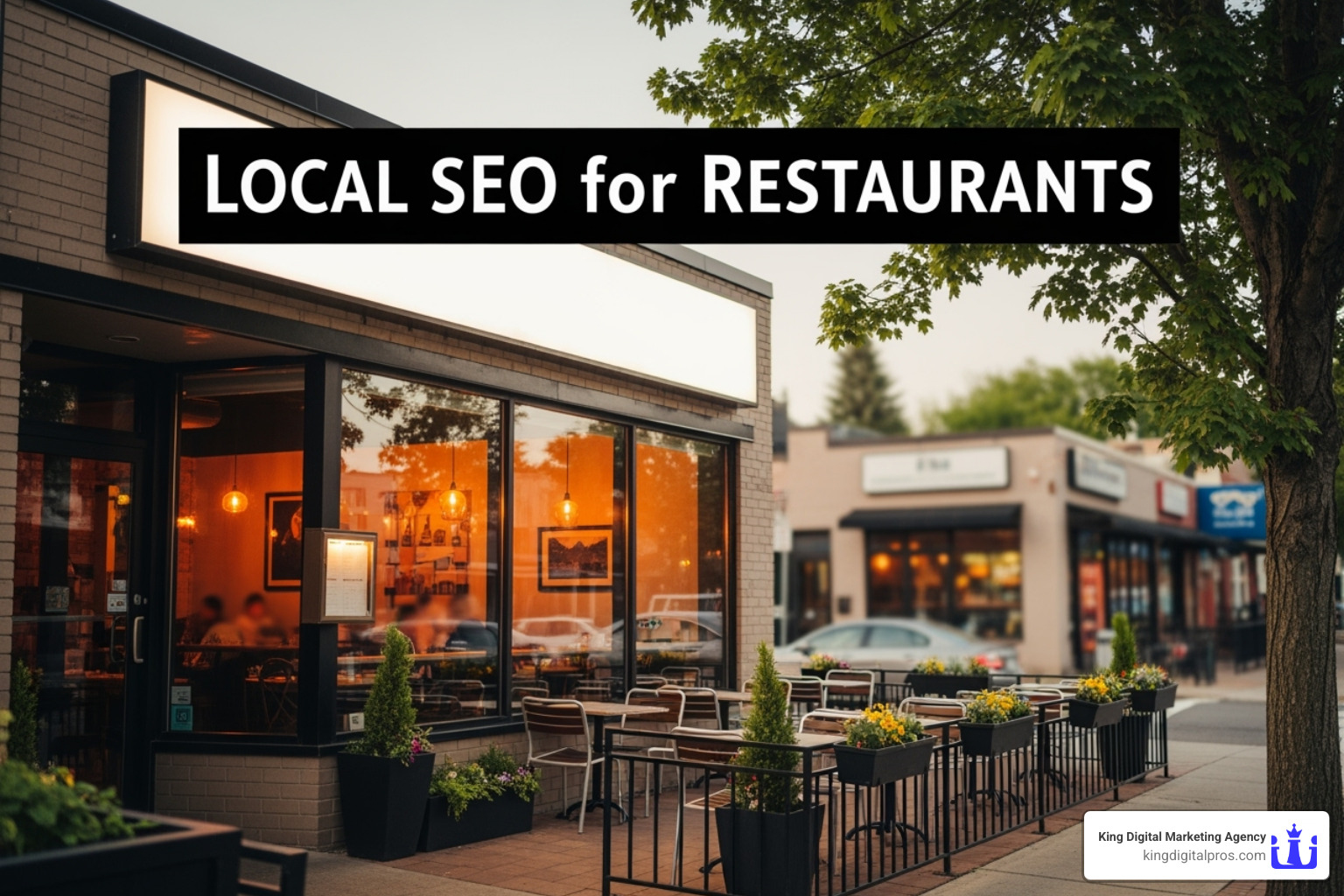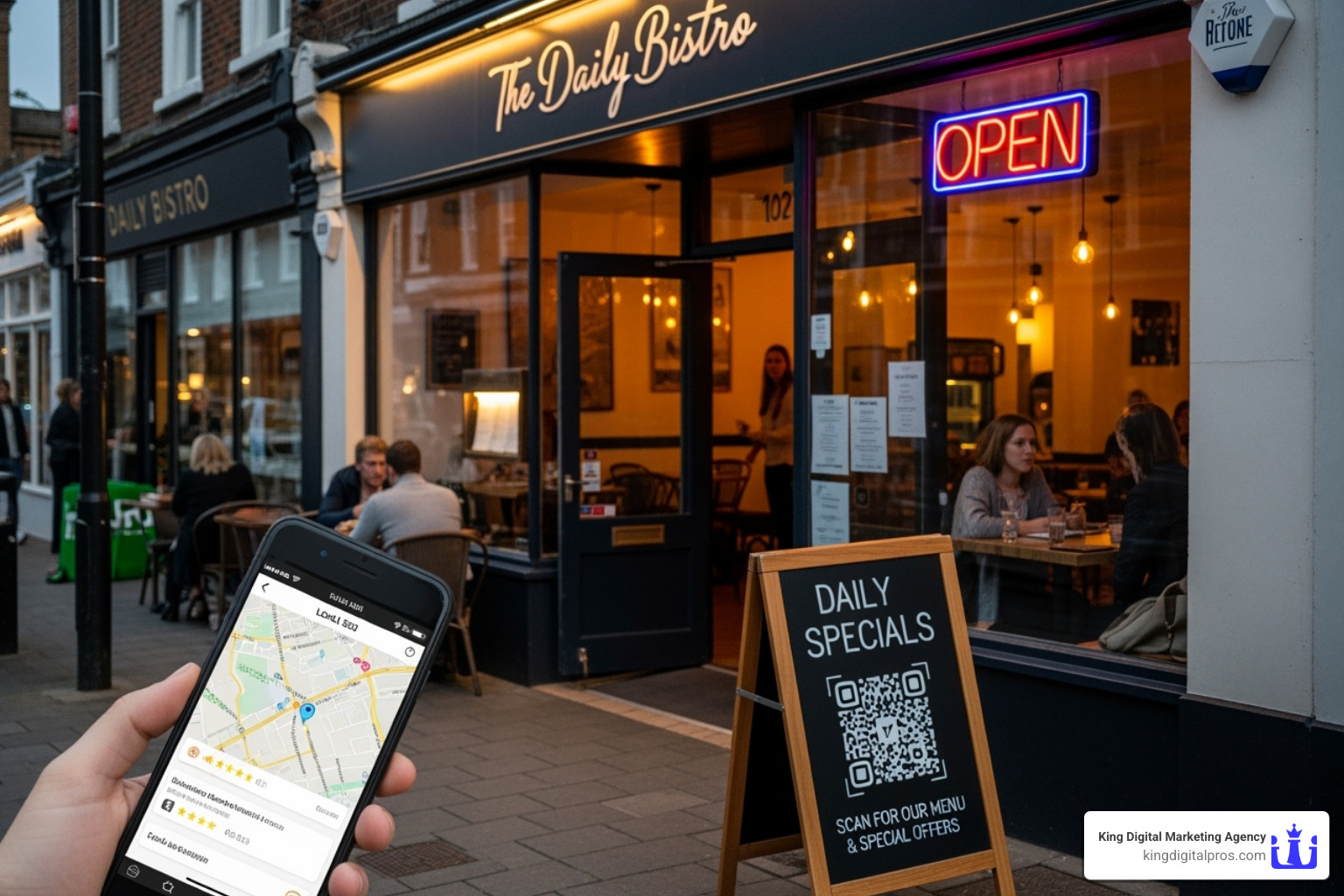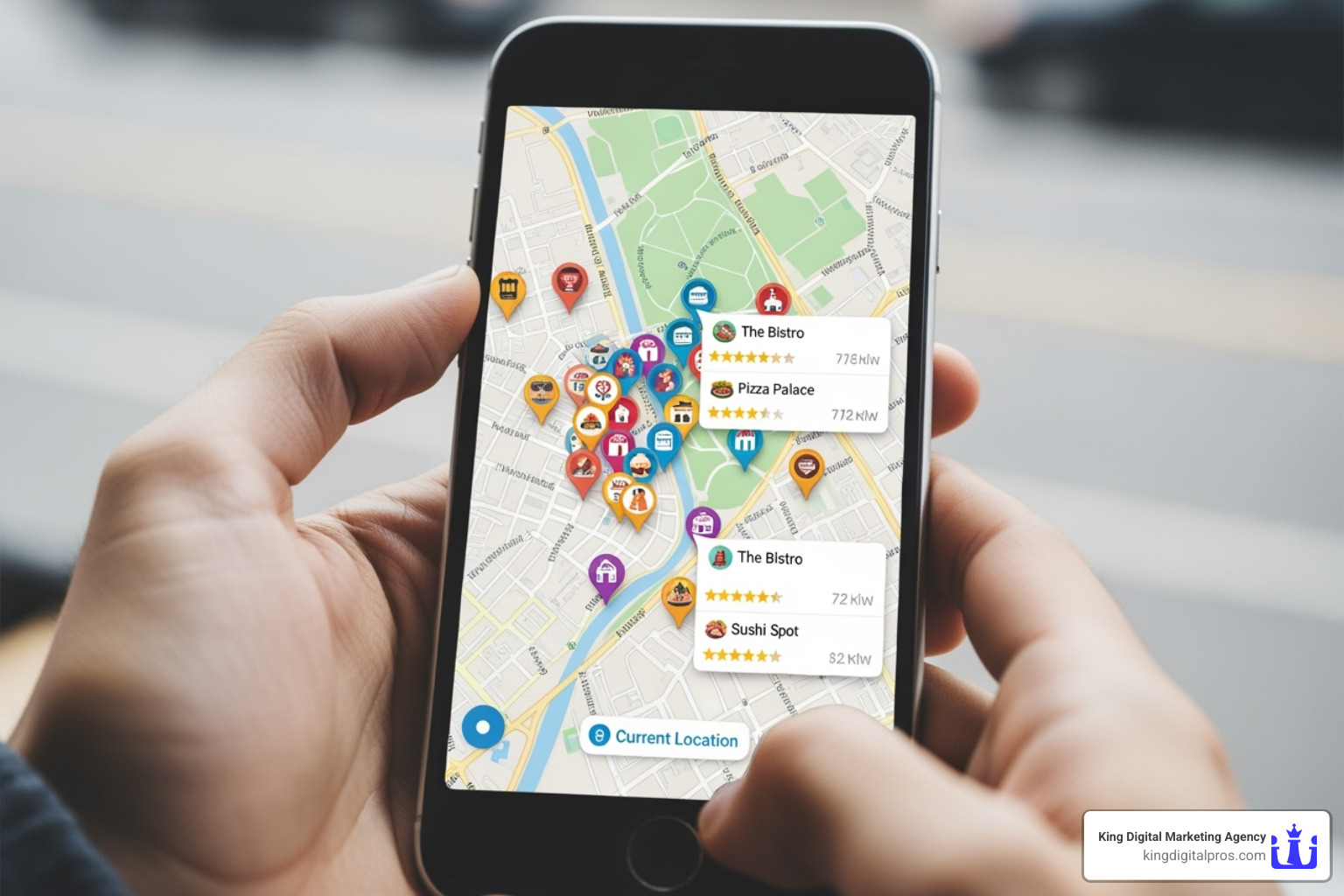Why Local SEO for Restaurants is Your Key to More Diners
Local SEO for restaurants is the process of optimizing your online presence to appear when hungry customers search for dining options nearby. To dominate local search, you need to focus on these core components:
- Google Business Profile: Your digital storefront in Google Maps and search.
- Online Reviews: Build trust with the 87% of consumers who read reviews.
- Local Citations: Ensure consistent business information across directories like Yelp.
- Location-Based Keywords: Target searches like “best pizza near me.”
- Mobile-Friendly Website: Crucial, as over 70% of local searches are on mobile.
The data is clear: 46% of all Google searches are local, and 76% of people who search for a local business visit within 24 hours. For restaurants, a missed opportunity in local search is a lost customer.
When someone searches “lunch near me,” will they find you? If you’re not in the top three local results – the “local pack” – you’re invisible to most diners.
I’m Bernadette King, founder of King Digital Marketing Agency. I’ve helped countless restaurant owners transform their visibility with strategic Local SEO for restaurants. My experience has shown me what it takes to get restaurants found by their ideal customers.

Local SEO for restaurants terms at a glance:
The Foundation: Mastering Your Google Business Profile
Your Google Business Profile (GBP) is your restaurant’s digital front door. For many customers, it’s their first impression. When someone searches “best Italian restaurant near me,” your GBP often appears before your website, making this free tool essential for Local SEO for restaurants. A well-optimized profile can be the difference between a customer choosing you or a competitor.
Claiming and Optimizing Your Core Information
If you haven’t claimed your Google Business Profile, do it now. Search for your restaurant on Google Maps, click “Manage This Page,” and follow the verification process, which usually involves a postcard with a code sent to your address. This step ensures accuracy and builds trust with Google.
Once verified, fill out every field completely. Your business name must match your storefront. Include your full address, phone number, and website. Select specific business categories, like “Italian Restaurant” instead of just “Restaurant,” to help Google match you with relevant searches. A complete profile is more likely to appear in local search results.
Need help? This video on how to improve your local ranking on Google is a great resource, or our team can handle it with our Google Business Listing Help service.
Why NAP Consistency is Non-Negotiable
Many restaurants hurt their rankings with NAP inconsistency. NAP (Name, Address, Phone Number) must be identical everywhere online—your website, GBP, social media, and all directories.
Google acts like a detective verifying your information. Conflicting details create confusion and erode trust, which directly harms your local search rankings. Is it “Mario’s Pizza” or “Mario’s Pizzeria”? This uncertainty can cause you to disappear from local results. Consistent NAP is a powerful trust signal for search engines, telling them they can confidently present your restaurant to searchers.

Engaging Customers with Rich GBP Features
Your GBP is a dynamic marketing platform. Use its features to attract more diners.
- High-Quality Photos: Restaurants with photos get 42% more direction requests. Upload mouth-watering images of your dishes, interior, and staff. Follow Google’s photo guidelines for best results.
- Menu Uploads: Provide your menu in a text-based format, not just a PDF. This helps search engines read it and allows customers to find you when searching for specific dishes.
- Service Attributes: Mark all relevant attributes like “outdoor seating,” “delivery,” or “wheelchair accessible.” These help you appear in specific searches.
- Google Posts: Use these free mini-ads to promote specials, events, or new menu items. Include a photo and a clear call-to-action like “Order Online.”
- Q&A Section: Proactively answer common questions like “Do you take reservations?” to show you’re engaged and helpful, building trust with potential diners.
Managing these features can be overwhelming. Our Google Business Page Management service can keep your profile optimized while you focus on creating amazing dining experiences.
Building Authority: Citations, Reviews, and Local Links
While your Google Business Profile is the center of your online presence, Local SEO for restaurants thrives on strong external connections. These come in three forms: citations, reviews, and local links.
The Power of Local Citations and Directories
A citation is any online mention of your restaurant’s name, address, and phone number (NAP), even without a link. Search engines use these mentions to fact-check your business. Consistent information across trusted directories builds confidence that your business is established and legitimate.
Citations also help customers find you directly on platforms like Yelp or TripAdvisor. Key directories for restaurants include Google Business Profile, Yelp, TripAdvisor, OpenTable, Foursquare, Apple Maps, and Bing Places. NAP consistency across all these platforms is critical. Fill out each listing completely with photos and detailed descriptions to maximize its value.
Mastering Online Reviews and Reputation
If citations are your foundation, reviews are your rocket fuel. 87% of consumers read online reviews before choosing a restaurant. Reviews heavily influence Google’s local rankings and are your best tool for building trust with potential diners.
Be proactive in getting reviews. When a customer offers a compliment, ask them to share their experience on Google. QR codes on receipts or table tents linking to your review page can make it easy for them.
Crucially, respond to every single review, both positive and negative. This shows you are engaged and care about the customer experience.

When responding to negative feedback, remain professional and empathetic. Thank them, acknowledge their concerns, and offer to make it right. Future customers will see a business that values service.
Earning High-Value Local Backlinks
Backlinks are digital referrals. When other websites link to yours, they signal to search engines that your restaurant is noteworthy. For Local SEO for restaurants, local backlinks are especially valuable because they confirm your role in the community.
- Food Bloggers & Influencers: Invite them for a meal in exchange for an honest review and a potential link.
- Local News: Pitch interesting stories about your restaurant, like a new menu or special event, to local media for coverage.
- Community Sponsorships: Sponsoring a local festival or charity event often earns you a link on their website.
- Local Partnerships: Team up with non-competing businesses, like a nearby brewery, for cross-promotion.
These connections do more than boost search rankings; they weave your restaurant into the community. For more strategies, see our guide on Attracting Customers Via Google Maps.
Your Digital Storefront: On-Page and Technical Local SEO for Restaurants
Your website is your digital storefront where customers decide whether to visit. While your Google Business Profile gets you found, your website seals the deal. Let’s optimize your site for both search engines and potential diners.
Finding the Best Local Keywords for Your Restaurant
Understand how customers search. They use specific phrases like “tacos downtown Albuquerque” or “family-friendly restaurant with patio.” This is the foundation of effective Local SEO for restaurants.
Your strategy should focus on cuisine + city/neighborhood combinations. “Near me” searches are incredibly popular, so optimizing for them is key. Long-tail keywords like “gluten-free pizza near me in Los Alamos” capture high-intent customers who are ready to buy. Don’t forget branded keywords for people already searching for your restaurant’s name.
Tools like Google Keyword Planner can reveal what people in your area are searching for. For expert help, our Local SEO Keyword Research services can pinpoint the most effective terms for your business.
Critical On-Page SEO for Your Website
Once you have your keywords, weave them naturally into your website.
- Title Tags: These are your marquee signs in search results. A good title like “Best Italian Restaurant in Santa Fe | [Your Restaurant Name]” tells Google and users what you offer. Keep them under 60 characters.
- Meta Descriptions: This is your 160-character elevator pitch. Make it compelling: “Experience authentic Italian cuisine in Santa Fe. Fresh pasta, exquisite wines, and a cozy atmosphere. Book your table today!“
- Header Tags (H1, H2): Use your main keyword in the H1 tag. Use related terms in H2 and H3 subheadings, like “Our Delicious Pizza Menu in Corrales, NM.”
- Location-Specific Content: Create dedicated Local SEO Location Pages for each restaurant if you have multiple locations. Each page needs unique NAP, hours, and local keywords.
- Embed a Google Map: Always include a map on your contact page to provide a visual cue and reinforce your location to search engines.
Technical SEO that Boosts Local Performance
The technical health of your site is critical for Local SEO for restaurants.
- Mobile-First Design: This is non-negotiable. Google primarily uses your mobile site for ranking, and most local searches happen on mobile. A poor mobile experience will send customers to your competitors.
- Page Speed: Hungry customers are impatient. If your site is slow, they will leave. Optimize images and code for fast loading times.
- HTTPS Security: The padlock in the browser bar signals a secure site, which is essential for online orders and building trust. Google favors secure websites.
- Local Business Schema: This structured data helps Google understand your restaurant’s information, leading to rich snippets (star ratings, hours) in search results. Find guidelines at Schema.org’s LocalBusiness page.

A technically sound website ensures a smooth user experience, encouraging visitors to choose your restaurant.
Measuring Success and Setting Expectations
You’ve optimized your profiles and website. Now, how do you know if your Local SEO for restaurants efforts are paying off? Tracking your progress is key to understanding what’s working.
Key Metrics for Tracking Your Local SEO for restaurants
Digital marketing provides detailed insights into customer behavior. Here’s what to watch:
- Google Business Profile Insights: This free tool shows how people found you (direct vs. findy searches) and what actions they took, such as website visits, calls, or direction requests.
- Website Organic Traffic: Use a tool like Google Analytics to see how many people find your site through unpaid search. A rise in local visitors is a great sign.
- Keyword Rankings: Track your position for key search terms like “best Italian restaurant downtown.” Moving into the top three results can dramatically increase foot traffic.
- Conversion Rate: This is the ultimate metric. Are online visitors becoming customers? Track reservations, online orders, and calls to measure your return on investment.
- Direct Actions: Phone calls and direction requests from your GBP are high-value conversions, as they represent people ready to visit or order immediately.
How Long Does Local SEO Take to Show Results?
Local SEO for restaurants is a long-term strategy, not an overnight fix. Most restaurants see meaningful improvements within 3-6 months of consistent effort. While you might see quick wins, the substantial changes that impact your bottom line take time to develop.
Several factors influence this timeline. A highly competitive market requires more effort to stand out. Your starting point also matters; a restaurant with no prior online presence has more ground to cover but also more room for dramatic improvement.
Consistency is crucial. Local SEO isn’t a “set it and forget it” task. It requires ongoing attention, regular updates, and continuous engagement. The restaurants that dominate local search treat their online presence as seriously as their food and service.
Frequently Asked Questions about Local SEO for Restaurants
Diving into Local SEO for restaurants can feel overwhelming. Here are answers to the most common questions we hear from restaurant owners.
What are the most important factors for local restaurant rankings?
While Google’s exact formula is a secret, local rankings are based on three main pillars:
- Relevance: How well your profile and website match a user’s search query. If someone searches “gluten-free pizza,” and your profile highlights that option, you are highly relevant.
- Distance: How close your business is to the searcher’s location. You can’t change your address, but you can ensure Google knows exactly where you are.
- Prominence: How well-known and trusted your restaurant is online. This is measured by review quantity and quality, links from other authoritative sites, and the overall completeness of your GBP.
How does voice search impact restaurants?
Nearly 50% of searches are now voice-based, using conversational queries like, “Hey Google, what’s a good Italian place that’s open right now?” To appear in these results, your Google Business Profile must be accurate and complete, as smart assistants pull information directly from it. A mobile-friendly site with clear, conversational content and an FAQ section that answers common questions also helps you get found through voice search.
Can I do local SEO myself, or should I hire an expert?
You can absolutely handle some Local SEO for restaurants tasks yourself. Claiming your GBP, keeping information updated, uploading photos, and responding to reviews are manageable and effective foundational steps.
However, a comprehensive strategy involves technical SEO, keyword research, link building, and constant monitoring, which require specialized knowledge and significant time. In competitive markets, an expert can deliver faster, more substantial results while you focus on creating amazing dining experiences. The right choice depends on your time, technical comfort, and market competitiveness. If you’re considering professional help, you can learn more about our SEO services.
Conclusion: Your Recipe for Local Search Success
Think of Local SEO for restaurants like crafting your signature dish – it requires the right ingredients and consistent technique. You need an optimized Google Business Profile, a steady stream of positive reviews, and a technically sound, mobile-friendly website.
When you focus on these core areas, your restaurant starts appearing when locals search for their next meal. Your phone rings more, customers find you on Google Maps, and your revenue grows.
Local SEO for restaurants is not a one-time project; it’s an ongoing commitment. The businesses that treat it seriously are the ones that consistently outrank their competition.
I’ve seen countless restaurant owners transform their businesses by prioritizing local search, from small cafes to busy downtown restaurants. The formula works.
At King Digital Marketing Agency, we specialize in turning your online presence into your most valuable marketing asset. We handle the technical details and ongoing optimization so you can focus on what you do best – creating amazing dining experiences.
Ready to get more diners through your door? Whether you’re in Albuquerque, Rio Rancho, Santa Fe, or the surrounding areas, we’re here to help your restaurant become the local favorite. Explore our digital marketing services and let’s start cooking up your local search success story.

